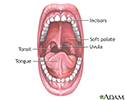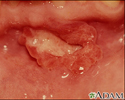Canker sore
Aphthous ulcer; Ulcer - aphthousA canker sore is a painful, open sore in the mouth. Canker sores are white or yellow and surrounded by a bright red area. They are not cancerous.
A canker sore is not the same as a fever blister (cold sore).
Fever blister
Oral herpes is an infection of the lips, mouth, or gums due to the herpes simplex virus. It causes small, painful blisters commonly called cold sore...

Causes
Canker sores are a common form of mouth ulcer. They may occur with viral infections. In some cases, the cause is unknown.
Mouth ulcer
Mouth ulcers are sores or open lesions in the mouth.

Canker sores may also be linked to problems with the body's immune system. The sores may also be brought on by:
- Mouth injury from dental work
- Cleaning the teeth too roughly
- Biting the tongue or cheek
Other things that can trigger canker sores include:
- Emotional stress
- Lack of certain vitamins and minerals in the diet (especially iron, folic acid, or vitamin B-12)
Folic acid
Folic acid and folate are both terms for a type of B vitamin (vitamin B9). The terms folic acid and folate are often used interchangeably. Folate is...
 ImageRead Article Now Book Mark Article
ImageRead Article Now Book Mark ArticleVitamin B-12
Vitamin B12 is a water-soluble vitamin. Water-soluble vitamins dissolve in water. After the body uses what it needs of these vitamins, leftover amo...
 ImageRead Article Now Book Mark Article
ImageRead Article Now Book Mark Article - Hormonal changes
-
Food allergies
Food allergies
A food allergy is a type of immune response triggered by eggs, peanuts, milk, shellfish or some other specific food.
 ImageRead Article Now Book Mark Article
ImageRead Article Now Book Mark Article
Anyone can develop a canker sore. Women are more likely to get them than men. Canker sores may run in families.
Symptoms
Canker sores most often appear on the inner surface of the cheeks and lips, tongue, upper surface of the mouth, and the base of the gums.
Symptoms include:
- One or more painful, red spots or bumps that develops into an open ulcer
- White or yellow center
- Small size (most often under one third inch or 1 centimeter across)
- Gray color as healing starts
Less common symptoms include:
- Fever
- General discomfort or uneasiness (malaise)
-
Swollen lymph nodes
Swollen lymph nodes
Lymph nodes are present throughout your body. They are an important part of your immune system. Lymph nodes help your body recognize and fight germ...
 ImageRead Article Now Book Mark Article
ImageRead Article Now Book Mark Article
The pain often goes away in 7 to 10 days. It can take 1 to 3 weeks for a canker sore to completely heal. Large ulcers can take longer to heal.
Exams and Tests
Your health care provider can often make the diagnosis by looking at the sore.
If canker sores persist or continue to return, tests should be done to look for other causes, such as erythema multiforme, medicine allergies, herpes infection, and bullous lichen planus.
Erythema multiforme
Erythema multiforme (EM) is an acute skin reaction that comes from an infection or another trigger. EM is a self-limiting condition. This means it ...

Medicine allergies
Drug allergies are a group of symptoms caused by an allergic reaction to a drug (medicine).

Lichen planus
Lichen planus is a condition that forms a very itchy rash on the skin or in the mouth.

You may need further testing or a biopsy to look for other causes of mouth ulcers. Canker sores are not cancer and do not cause cancer. There are types of cancer, however, that may first appear as a mouth ulcer that does not heal.
Biopsy
A skin lesion biopsy is when a small amount of skin is removed so it can be examined under a microscope. The skin is tested to look for skin conditi...

Treatment
In most cases, the canker sores go away without treatment.
Try not to eat hot or spicy foods, which can cause pain.
Use over-the-counter medicines that ease pain in the area.
- Rinse your mouth with salt water or mild, over-the-counter mouthwashes. (DO NOT use mouthwashes that contain alcohol which can irritate the area more.)
- Apply a mixture of half hydrogen peroxide and half water directly to the sore using a cotton swab. Follow by dabbing a small amount of Milk of Magnesia on the canker sore afterward. Repeat these steps 3 to 4 times a day.
- Rinse your mouth with a mixture of half Milk of Magnesia and half Benadryl liquid allergy medicine. Swish mixture in the mouth for about 1 minute and then spit out.
- Over the counter numbing mouth rinses or drops can provide short term pain relief.
Medicines prescribed by your provider may be needed for severe cases. These may include:
- Chlorhexidine mouthwash
- Stronger medicines called corticosteroids that are placed on the sore or are taken in pill form
Brush your teeth twice a day and floss your teeth every day. Also, get routine dental check-ups.
In some cases, gastric acid-reducing medicines can decrease the discomfort.
Outlook (Prognosis)
Canker sores almost always heal on their own. The pain should decrease in a few days. Other symptoms disappear in 10 to 14 days.
When to Contact a Medical Professional
Contact your provider if:
- A canker sore or mouth ulcer does not go away after 2 weeks of home care or gets worse.
- You get canker sores more than 2 or 3 times a year.
- You have symptoms with the canker sore such as fever, diarrhea, headache, or skin rash.
References
Dhar VK. Common lesions of the oral soft tissues. In: Kliegman RM, St. Geme JW, Blum NJ, et al, eds. Nelson Textbook of Pediatrics. 22nd ed. Philadelphia, PA: Elsevier; 2025:chap 361.
Jordan RC. Diseases of the mouth and salivary glands. In: Goldman L, Cooney KA, eds. Goldman-Cecil Medicine. 27th ed. Philadelphia, PA: Elsevier; 2024:chap 393.
Klatt EC. Head and neck. In: Klatt EC, ed. Robbins and Cotran Atlas of Pathology. 4th ed. Philadelphia, PA: Elsevier; 2021:chap 6.
-
Canker sore - illustration
A canker sore is a common form of mouth ulcer, which appears as a painful white or yellow ulcer surrounded by a bright red area. A canker sore sore can be triggered by emotional stress, dietary deficiencies, menstrual periods, hormonal changes, food allergies or trauma in the mouth. Canker sores usually heal without treatment within two weeks.
Canker sore
illustration
-
Mouth anatomy - illustration
The mouth is the origination of the digestive tract. The teeth and salivary glands aid in breaking down food for digestion. The tonsils aid against infections.
Mouth anatomy
illustration
-
Canker sore (aphthous ulcer) - illustration
Canker sores (aphthous ulcers) are very common. Typically, they are a shallow ulcer with a white or whitish/yellow base surrounded by a reddish border. This severe form of ulcer can be seen in an individual with AIDS and is located in front and just below the bottom teeth.
Canker sore (aphthous ulcer)
illustration
-
Fever blister - illustration
A fever blister is a sore from an infection caused by the herpes simplex virus, characterized by an eruption of small and usually painful blisters on the skin of the lips, mouth, gums, or the skin around the mouth. A fever blister is highly contagious. A canker sore is a benign, open sore in the mouth, which appears as a painful white or yellow sore (ulcer) surrounded by a bright red area, which is not contagious. A fever blister is very different from a canker sore, although they both develop in close proximity in area of the mouth.
Fever blister
illustration
-
Canker sore - illustration
A canker sore is a common form of mouth ulcer, which appears as a painful white or yellow ulcer surrounded by a bright red area. A canker sore sore can be triggered by emotional stress, dietary deficiencies, menstrual periods, hormonal changes, food allergies or trauma in the mouth. Canker sores usually heal without treatment within two weeks.
Canker sore
illustration
-
Mouth anatomy - illustration
The mouth is the origination of the digestive tract. The teeth and salivary glands aid in breaking down food for digestion. The tonsils aid against infections.
Mouth anatomy
illustration
-
Canker sore (aphthous ulcer) - illustration
Canker sores (aphthous ulcers) are very common. Typically, they are a shallow ulcer with a white or whitish/yellow base surrounded by a reddish border. This severe form of ulcer can be seen in an individual with AIDS and is located in front and just below the bottom teeth.
Canker sore (aphthous ulcer)
illustration
-
Fever blister - illustration
A fever blister is a sore from an infection caused by the herpes simplex virus, characterized by an eruption of small and usually painful blisters on the skin of the lips, mouth, gums, or the skin around the mouth. A fever blister is highly contagious. A canker sore is a benign, open sore in the mouth, which appears as a painful white or yellow sore (ulcer) surrounded by a bright red area, which is not contagious. A fever blister is very different from a canker sore, although they both develop in close proximity in area of the mouth.
Fever blister
illustration
Review Date: 4/3/2025
Reviewed By: Ashutosh Kacker, MD, FACS, Professor of Clinical Otolaryngology, Weill Cornell Medical College, and Attending Otolaryngologist, New York-Presbyterian Hospital, New York, NY. Review provided by VeriMed Healthcare Network. Also reviewed by David C. Dugdale, MD, Medical Director, Brenda Conaway, Editorial Director, and the A.D.A.M. Editorial team.





